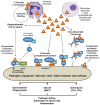Local release of properdin in the cellular microenvironment: role in pattern recognition and amplification of the alternative pathway of complement
- PMID: 23335922
- PMCID: PMC3547370
- DOI: 10.3389/fimmu.2012.00412
Local release of properdin in the cellular microenvironment: role in pattern recognition and amplification of the alternative pathway of complement
Abstract
Properdin, the only positive regulatory protein of the complement system, acts as both a stabilizer of the alternative pathway (AP) convertases and as a selective pattern recognition molecule of certain microorganisms and host cells (i.e., apoptotic/necrotic cells) by serving as a platform for de novo C3b,Bb assembly. Properdin, a highly positively charged protein, normally exists as cyclic dimers (P(2)), trimers (P(3)), and tetramers (P(4)) of head-to-tail associations of monomeric 53 kDa subunits. While most complement proteins are produced mainly in the liver, properdin is synthesized primarily by various cell types, including neutrophils, monocytes, primary T cells, and shear-stressed endothelial cells resulting in properdin serum levels of 4-25 μg/ml. Multiple inflammatory agonists stimulate the release of properdin from stimulated leukocytes into the cellular microenvironment. Concentrated, focused increases in properdin levels may lead to stabilization and initiation of AP convertases, thus greatly amplifying the complement response to a local stimulus. This review highlights current knowledge related to these properties and discusses the implications of properdin production in a pro-inflammatory microenvironment.
Keywords: alternative pathway; complement system; inflammation; pattern recognition; properdin.
Figures

References
-
- Bongrazio M., Pries A. R., Zakrzewicz A. (2003). The endothelium as physiological source of properdin: role of wall shear stress. Mol. Immunol. 39 669–675 - PubMed
-
- Camous L., Roumenina L., Bigot S., Brachemi S., Fremeaux-Bacchi V., Lesavre P., et al. (2011). Complement alternative pathway acts as a positive feedback amplification of neutrophil activation. Blood 117 1340–1349 - PubMed
Grants and funding
LinkOut - more resources
Full Text Sources
Other Literature Sources

